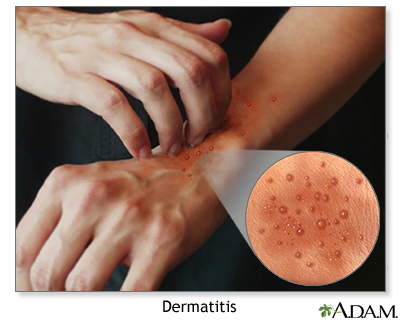Pityriasis alba
Pityriasis alba is a common skin disorder that causes patches of light-colored (hypopigmented) areas.
Images

I Would Like to Learn About:
Causes
The cause is unknown but may be linked to atopic dermatitis (eczema). The disorder is most common in children and teens. It is more noticeable in children with dark skin.
Symptoms
The problem areas on the skin (lesions) often start as slightly red and scaly patches that are round or oval. They usually appear on the face, upper arms, neck, and upper middle of the body. After these lesions go away, the patches turn light-colored (hypopigmented).
The patches do not tan easily. Because of this, they may get red quickly in the sun. As the skin surrounding the patches darkens normally, the patches may become more visible.
Exams and Tests
Your health care provider can usually diagnose the condition by looking at the skin. Tests, such as potassium hydroxide (KOH), may be done to check for other skin problems. In very rare cases, a skin biopsy is done.
Treatment
Your provider may recommend the following treatments:
- Moisturizer
- Mild steroid creams
- Medicine, called immunomodulators, applied to the skin to reduce inflammation
- Treatment with ultraviolet light to control the inflammation
- Medicines by mouth or shots to control the dermatitis, if severe
- Laser treatment
Outlook (Prognosis)
Pityriasis alba usually goes away on its own with patches returning to normal pigment over many months.
Possible Complications
Patches may get sunburned when exposed to sunlight. Applying sunscreen and using other sun protection can help prevent sunburn.
When to Contact a Medical Professional
Contact your provider if your child has patches of hypopigmented skin.
Related Information
Atopic dermatitisReferences
Dinulos JGH. Light-related diseases and disorders of pigmentation. In: Dinulos JGH, ed. Habif's Clinical Dermatology. 7th ed. Philadelphia, PA: Elsevier; 2021:chap 19.
Patterson JW. Disorders of pigmentation. In: Patterson JW, ed. Weedon's Skin Pathology. 5th ed. Philadelphia, PA: Elsevier; 2021:chap 11.
BACK TO TOPReview Date: 5/31/2023
Reviewed By: Ramin Fathi, MD, FAAD, Director, Phoenix Surgical Dermatology Group, Phoenix, AZ. Also reviewed by David C. Dugdale, MD, Medical Director, Brenda Conaway, Editorial Director, and the A.D.A.M. Editorial team.

Health Content Provider
06/01/2025
|
A.D.A.M., Inc. is accredited by URAC, for Health Content Provider (www.urac.org). URAC's accreditation program is an independent audit to verify that A.D.A.M. follows rigorous standards of quality and accountability. A.D.A.M. is among the first to achieve this important distinction for online health information and services. Learn more about A.D.A.M.'s editorial policy, editorial process and privacy policy. A.D.A.M. is also a founding member of Hi-Ethics. This site complied with the HONcode standard for trustworthy health information from 1995 to 2022, after which HON (Health On the Net, a not-for-profit organization that promoted transparent and reliable health information online) was discontinued. |
The information provided herein should not be used during any medical emergency or for the diagnosis or treatment of any medical condition. A licensed medical professional should be consulted for diagnosis and treatment of any and all medical conditions. Links to other sites are provided for information only -- they do not constitute endorsements of those other sites. © 1997- 2025 A.D.A.M., a business unit of Ebix, Inc. Any duplication or distribution of the information contained herein is strictly prohibited.
